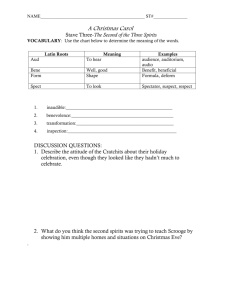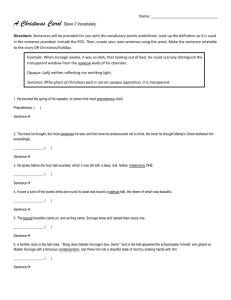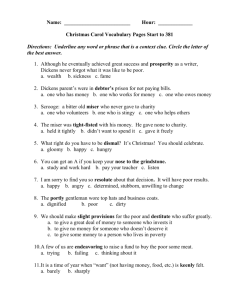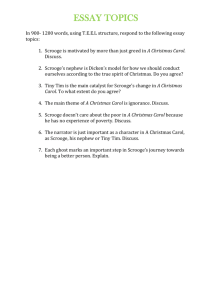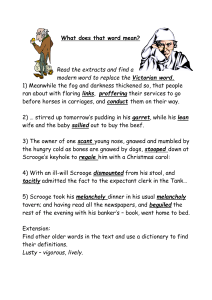Christmas Carol Knowledge Organiser
advertisement
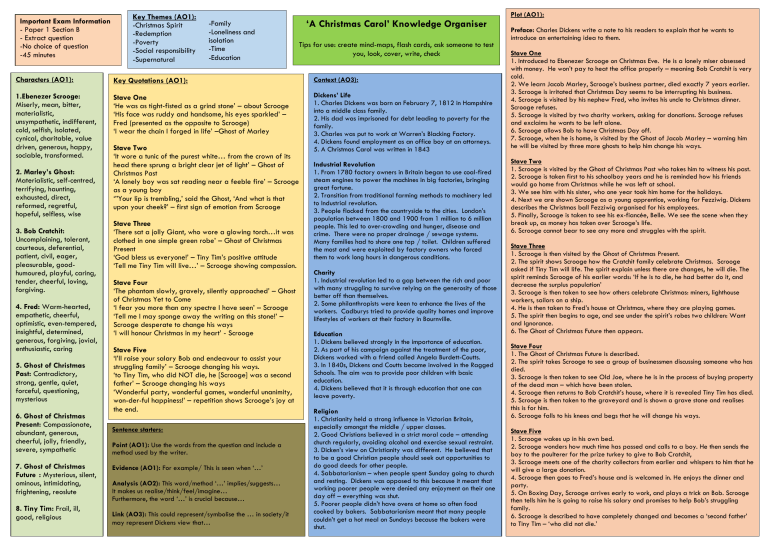
Important Exam Information - Paper 1 Section B - Extract question -No choice of question -45 minutes Key Themes (AO1): -Christmas Spirit -Redemption -Poverty -Social responsibility -Supernatural -Family -Loneliness and isolation -Time -Education ‘A Christmas Carol’ Knowledge Organiser Tips for use: create mind-maps, flash cards, ask someone to test you, look, cover, write, check Characters (AO1): Key Quotations (AO1): Context (AO3): 1.Ebenezer Scrooge: Miserly, mean, bitter, materialistic, unsympathetic, indifferent, cold, selfish, isolated, cynical, charitable, value driven, generous, happy, sociable, transformed. Stave One ‘He was as tight-fisted as a grind stone’ – about Scrooge ‘His face was ruddy and handsome, his eyes sparkled’ – Fred (presented as the opposite to Scrooge) ‘I wear the chain I forged in life’ –Ghost of Marley Dickens’ Life 1. Charles Dickens was born on February 7, 1812 in Hampshire into a middle class family. 2. His dad was imprisoned for debt leading to poverty for the family. 3. Charles was put to work at Warren’s Blacking Factory. 4. Dickens found employment as an office boy at an attorneys. 5. A Christmas Carol was written in 1843 2. Marley’s Ghost: Materialistic, self-centred, terrifying, haunting, exhausted, direct, reformed, regretful, hopeful, selfless, wise 3. Bob Cratchit: Uncomplaining, tolerant, courteous, deferential, patient, civil, eager, pleasurable, goodhumoured, playful, caring, tender, cheerful, loving, forgiving. 4. Fred: Warm-hearted, empathetic, cheerful, optimistic, even-tempered, insightful, determined, generous, forgiving, jovial, enthusiastic, caring 5. Ghost of Christmas Past: Contradictory, strong, gentle, quiet, forceful, questioning, mysterious 6. Ghost of Christmas Present: Compassionate, abundant, generous, cheerful, jolly, friendly, severe, sympathetic 7. Ghost of Christmas Future : Mysterious, silent, ominous, intimidating, frightening, reoslute 8. Tiny Tim: Frail, ill, good, religious Stave Two ‘It wore a tunic of the purest white… from the crown of its head there sprung a bright clear jet of light’ – Ghost of Christmas Past ‘A lonely boy was sat reading near a feeble fire’ – Scrooge as a young boy ‘”Your lip is trembling,’ said the Ghost, ‘And what is that upon your cheek?’ – first sign of emotion from Scrooge Stave Three ‘There sat a jolly Giant, who wore a glowing torch…it was clothed in one simple green robe’ – Ghost of Christmas Present ‘God bless us everyone!’ – Tiny Tim’s positive attitude ‘Tell me Tiny Tim will live…’ – Scrooge showing compassion. Stave Four ‘The phantom slowly, gravely, silently approached’ – Ghost of Christmas Yet to Come ‘I fear you more than any spectre I have seen’ – Scrooge ‘Tell me I may sponge away the writing on this stone!’ – Scrooge desperate to change his ways ‘I will honour Christmas in my heart’ - Scrooge Stave Five ‘I’ll raise your salary Bob and endeavour to assist your struggling family’ – Scrooge changing his ways. ‘to Tiny Tim, who did NOT die, he [Scrooge] was a second father’ – Scrooge changing his ways ‘Wonderful party, wonderful games, wonderful unanimity, won-der-ful happiness!’ – repetition shows Scrooge’s joy at the end. Sentence starters: Point (AO1): Use the words from the question and include a method used by the writer. Evidence (AO1): For example/ This is seen when ‘…’ Analysis (AO2): This word/method ‘…’ implies/suggests… It makes us realise/think/feel/imagine… Furthermore, the word ‘…’ is crucial because… Link (AO3): This could represent/symbolise the … in society/it may represent Dickens view that… Industrial Revolution 1. From 1780 factory owners in Britain began to use coal-fired steam engines to power the machines in big factories, bringing great fortune. 2. Transition from traditional farming methods to machinery led to Industrial revolution. 3. People flocked from the countryside to the cities. London’s population between 1800 and 1900 from 1 million to 6 million people. This led to over-crowding and hunger, disease and crime. There were no proper drainage / sewage systems. Many families had to share one tap / toilet. Children suffered the most and were exploited by factory owners who forced them to work long hours in dangerous conditions. Charity 1. Industrial revolution led to a gap between the rich and poor with many struggling to survive relying on the generosity of those better off than themselves. 2. Some philanthropists were keen to enhance the lives of the workers. Cadburys tried to provide quality homes and improve lifestyles of workers at their factory in Bournville. Education 1. Dickens believed strongly in the importance of education. 2. As part of his campaign against the treatment of the poor, Dickens worked with a friend called Angela Burdett-Coutts. 3. In 1840s, Dickens and Coutts became involved in the Ragged Schools. The aim was to provide poor children with basic education. 4. Dickens believed that it is through education that one can leave poverty. Religion 1. Christianity held a strong influence in Victorian Britain, especially amongst the middle / upper classes. 2. Good Christians believed in a strict moral code – attending church regularly, avoiding alcohol and exercise sexual restraint. 3. Dicken’s view on Christianity was different. He believed that to be a good Christian people should seek out opportunities to do good deeds for other people. 4. Sabbatarianism – when people spent Sunday going to church and resting. Dickens was opposed to this because it meant that working poorer people were denied any enjoyment on their one day off – everything was shut. 5. Poorer people didn’t have ovens at home so often food cooked by bakers. Sabbatarianism meant that many people couldn’t get a hot meal on Sundays because the bakers were shut. Plot (AO1): Preface: Charles Dickens write a note to his readers to explain that he wants to introduce an entertaining idea to them. Stave One 1. Introduced to Ebenezer Scrooge on Christmas Eve. He is a lonely miser obsessed with money. He won’t pay to heat the office properly – meaning Bob Cratchit is very cold. 2. We learn Jacob Marley, Scrooge’s business partner, died exactly 7 years earlier. 3. Scrooge is irritated that Christmas Day seems to be interrupting his business. 4. Scrooge is visited by his nephew Fred, who invites his uncle to Christmas dinner. Scrooge refuses. 5. Scrooge is visited by two charity workers, asking for donations. Scrooge refuses and exclaims he wants to be left alone. 6. Scrooge allows Bob to have Christmas Day off. 7. Scrooge, when he is home, is visited by the Ghost of Jacob Marley – warning him he will be visited by three more ghosts to help him change his ways. Stave Two 1. Scrooge is visited by the Ghost of Christmas Past who takes him to witness his past. 2. Scrooge is taken first to his schoolboy years and he is reminded how his friends would go home from Christmas while he was left at school. 3. We see him with his sister, who one year took him home for the holidays. 4. Next we are shown Scrooge as a young apprentice, working for Fezziwig. Dickens describes the Christmas ball Fezziwig organised for his employees. 5. Finally, Scrooge is taken to see his ex-fiancée, Belle. We see the scene when they break up, as money has taken over Scrooge’s life. 6. Scrooge cannot bear to see any more and struggles with the spirit. Stave Three 1. Scrooge is then visited by the Ghost of Christmas Present. 2. The spirit shows Scrooge how the Cratchit family celebrate Christmas. Scrooge asked if Tiny Tim will life. The spirit explain unless there are changes, he will die. The spirit reminds Scrooge of his earlier words: ‘If he is to die, he had better do it, and decrease the surplus population’ 3. Scrooge is then taken to see how others celebrate Christmas: miners, lighthouse workers, sailors on a ship. 4. He is then taken to Fred’s house at Christmas, where they are playing games. 5. The spirit then begins to age, and see under the spirit’s robes two children: Want and Ignorance. 6. The Ghost of Christmas Future then appears. Stave Four 1. The Ghost of Christmas Future is described. 2. The spirit takes Scrooge to see a group of businessmen discussing someone who has died. 3. Scrooge is then taken to see Old Joe, where he is in the process of buying property of the dead man – which have been stolen. 4. Scrooge then returns to Bob Cratchit’s house, where it is revealed Tiny Tim has died. 5. Scrooge is then taken to the graveyard and is shown a grave stone and realises this is for him. 6. Scrooge falls to his knees and begs that he will change his ways. Stave Five 1. Scrooge wakes up in his own bed. 2. Scrooge wonders how much time has passed and calls to a boy. He then sends the boy to the poulterer for the prize turkey to give to Bob Cratchit, 3. Scrooge meets one of the charity collectors from earlier and whispers to him that he will give a large donation. 4. Scrooge then goes to Fred’s house and is welcomed in. He enjoys the dinner and party. 5. On Boxing Day, Scrooge arrives early to work, and plays a trick on Bob. Scrooge then tells him he is going to raise his salary and promises to help Bob’s struggling family. 6. Scrooge is described to have completely changed and becomes a ‘second father’ to Tiny Tim – ‘who did not die.’
